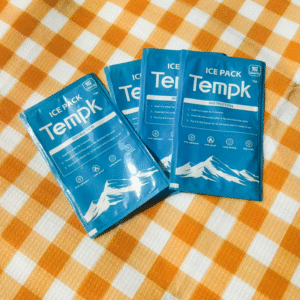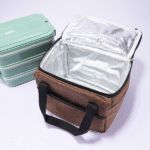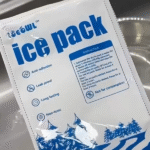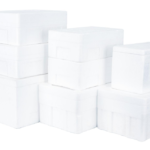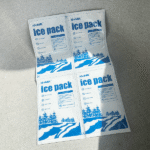Wenn es um die kalte Kette Versand geht, Die Auswahl der richtigen Kühlmethode ist entscheidend, um sicherzustellen, dass Ihre temperaturempfindlichen Produkte ihr Ziel in optimalem Zustand erreichen. Egal, ob Sie Pharmazeutika versenden, Essen, oder biologische Proben, Die richtige Wahl zwischen Trockeneis und Gelpackungen kann den Unterschied ausmachen. In diesem Leitfaden, Wir werden die einzigartigen Vorteile untersuchen, Anwendungen, und Umweltauswirkungen sowohl von Trockeneis- als auch von Gelpackungen, um die fundierteste Entscheidung zu treffen.
Schlüsselunterschiede zwischen Trockeneis und Gelpackungen
-
Temperaturbereich: Trockeneis bietet extreme Kühlung (-78.5°C / -109.3° F), Während Gelpacks besser zur mäßigen Kühlung sind (0-10°C / 32-50° F).
-
Kühldauer: Trockeneis dauert länger, Es ist ideal für Langstreckenversand, Während Gelpackungen besser für kürzere Reisen geeignet sind.
-
Kosten: Trockeneis ist tendenziell teurer, Während Gelpackungen erschwinglicher und wiederverwendbarer sind.
-
Umweltauswirkungen: Trockeneis freisetzt CO2 -Gas, hinterlässt aber keinen Rückstand, Während Gelpackungen wiederverwendbar sind und aus umweltfreundlicheren Materialien hergestellt werden.
Was ist Trockeneis?
Trockeneis, die feste Form von Kohlendioxid (Co₂), ist bekannt für seine extremen Kühlkapazitäten. Es behält eine Temperatur von ungefähr -78,5 ° C bei (-109.3° F), Es ist perfekt für Waren, die bei langen Reisen gefroren bleiben müssen.
Vorteile von Trockeneis:
-
Extrem niedrige Temperaturen: Ideal für gefrorene Güter wie Arzneimittel, Biologische Proben, und verderbliche Lebensmittel.
-
Keine flüssigen Rückstände: Verhindert feuchtigkeitsbedingte Schäden, Ein häufiges Problem mit normalem Eis.
-
Langzeitkühlung: Geeignet für Sendungen über verlängerte Dauer, einschließlich internationaler Sendungen.
Gemeinsame Anwendungen:
-
Pharmazeutika: Erhalt von Impfstoffen, Biologika, und andere empfindliche Materialien.
-
Lebensmitteltransport: Gewährleistung von gefrorenen Lebensmitteln wie Eiscreme, gefrorenes Fleisch, und Meeresfrüchte bleiben gefroren.
Was sind Gelpackungen??
Gelpackungen sind flexible Beutel mit ungiftigem Gel gefüllt, das bei Temperaturen über 0 ° C gefriert (32° F). Während sie nicht die niedrigen Temperaturen von Trockeneis erreichen, Sie bieten eine effektive Kühlung für Produkte, die gekühlt bleiben müssen, aber nicht gefroren sind.
Vorteile von Gelpackungen:
-
Wiederverwendbarkeit: Kann mehrmals wiederhergestellt und verwendet werden, sie zu einer kostengünstigen und nachhaltigen Option machen.
-
Leichte Handhabung: Gelpakete sind ungiftig, erfordern kein besonderes Handling, und sind sicher für die meisten Arten von Produkten.
-
Vielseitig: Geeignet für eine breite Palette von Produkten, von Pharmazeutika bis hin zu verderblichen Lebensmitteln.
Gemeinsame Anwendungen:
-
Kosmetik und Körperpflege: Aufrechterhaltung stabiler Temperaturen für Produkte wie Hautpflege und Kosmetik.
-
Frische Produkte und Milchprodukte: Versand frischer Früchte, Gemüse, und Milchprodukte, die cool bleiben müssen, aber nicht gefroren sind.
Trockeneis gegen Gelpackungen: Welches sollten Sie wählen?
Wann man Trockeneis benutzt:
-
Gefrorene Waren: Für Sendungen, die unter dem Gefrierpunkt bleiben müssen, wie gefrorene Lebensmittel und Impfstoffe.
-
Lange Transitzeiten: Wenn die Versanddauer verlängert wird, Trockeneis stellt sicher, dass die Waren über lange Zeiträume eingefroren bleiben.
-
Kein flüssiger Rückstand gewünscht: Wenn es entscheidend ist, Feuchtigkeitsschäden zu verhindern, Trockeneis ist die bessere Option.
Wann können Gelpackungen verwendet werden:
-
Gekühlte Waren: Für Artikel, die nur cool bleiben müssen, wie frische Produkte oder Kosmetika.
-
Kurze Transitzeiten: Wenn die Versanddauer kurz ist, Gelpakete bieten eine effektive Kühllösung, ohne dass extreme Temperaturen erforderlich sind.
-
Nachhaltigkeit: Gelpakete sind umweltfreundlicher und wiederverwendbarer, Sie ideal für Unternehmen, die ihre Umweltauswirkungen verringern möchten, ideal für Unternehmen.
Kostenüberlegungen: Welches ist erschwinglicher?
Während Trockeneis ist aufgrund seiner höheren Kühlungseffizienz und speziellen Handhabungsanforderungen teurer, Gelpackungen bieten eine wirtschaftlichere Lösung. Sie sind wiederverwendbar, Reduzierung der Kosten pro Sendung, insbesondere für Unternehmen mit regelmäßigen Versandanforderungen.
| Aspekt | Trockeneis | Gelpackungen | Praktische Vorteile |
|---|---|---|---|
| Temperaturbereich | Unter -78,5 ° C. (-109.3° F) | 0° C bis 10 ° C. (32° F bis 50 ° F.) | Trockeneis zum Einfrieren, Gelpackungen zur mäßigen Kühlung |
| Umgang mit Komplexität | Erfordert eine besondere Handhabung | Leicht zu handhaben, Keine besonderen Vorsichtsmaßnahmen | Gelpakete sind benutzerfreundlich |
| Kosten | Höher | Untere | Gelpakete bieten günstigere Lösungen |
| Wiederverwendbarkeit | Einweg | Wiederverwendbar | Gelpakete bieten langfristige Einsparungen |
| Umweltauswirkungen | CO2 -Emissionen aus Sublimation | Umweltfreundlicher | Gelpakete sind wiederverwendbar und umweltverträglich nachhaltig |
Umweltauswirkungen: Welche Option für den Planeten besser ist?
Trockeneis Freisetzt Co₂ Gas in die Atmosphäre, Beitrag zu Treibhausgasemissionen. Jedoch, Die minimalen Rückstände und die lang anhaltende Kühlfähigkeit machen es zu einer bevorzugten Option für Sendungen, die extrem Kälte erfordern.
Gelpackungen, auf der anderen Seite, sind wiederverwendbar und aus nachhaltigeren Materialien hergestellt. Sie haben einen kleineren Umwelt Fußabdruck, vor allem, wenn sie mehrmals verwendet werden. Innovationen in biologisch abbaubaren Gelpackmaterialien verbessern ihre ökologische Nachhaltigkeit weiter.
Kombinieren Sie Trockeneis- und Gelpackungen für eine optimale Schifffahrtsversand
In einigen Fällen, Es kann vorteilhaft sein, sowohl Trockeneis- als auch Gelpackungen zusammen zu verwenden. Diese Kombination kann liefern extrem kalt für bestimmte Produkte während Mäßige Kühlung für andere, Ermöglichen Sie eine ausgewogenere und kostengünstigere Lösung.
2025 Trends in der Kaltkette Versand: Trockeneis gegen Gelpackungen
Die Kaltkette -Schifffahrtsbranche entwickelt sich weiterhin als Reaktion auf steigende Anforderungen an nachhaltige und effiziente Lösungen. In 2025, Wir erwarten:
-
Intelligente Verpackungen: Temperaturüberwachungssysteme helfen Unternehmen, ihre Sendungen in Echtzeit zu verfolgen, Sicherstellen, dass die Waren in den erforderlichen Temperaturbereichen bleiben.
-
Umweltfreundliche Materialien: Fortschritte in biologisch abbaubaren Gelpackmaterialien machen sie noch umweltfreundlicher.
-
Energieeffizienter Versand: Solarbetriebene Versandlösungen erhalten Traktion, Reduzierung des CO2 -Fußabdrucks der Kaltkettenlogistik.
FAQ
Q1: Kann ich Trockeneis für den Versand gefrorener Lebensmittel verwenden??
Ja, Trockeneis ist ideal für den Versand gefrorener Lebensmittel, da es extrem niedrige Temperaturen beibehält.
Q2: Sind Gelpakete wiederverwendbar?
Ja, Gelpakete können mehrmals wiederverwendet und wiederverwendet werden, sie zu einer nachhaltigen und kostengünstigen Option für die Schifffahrtsversand machen.
Abschluss: Treffen Sie die richtige Wahl für Ihre kalten Schifffahrtsbedürfnisse
Bei der Wahl zwischen Trockeneis und Gelpackungen, Die beste Lösung hängt von den Temperaturanforderungen Ihrer Sendung ab, Dauer, Kostenüberlegungen, und Umweltauswirkungen. Trockeneis ist ideal für gefrorene Güter und Fernversand, Während Gelpacks für gekühlte Waren und kürzere Reisen besser sind. Durch sorgfältige Bewertung Ihrer spezifischen Bedürfnisse, Sie können die effektivste und kostengünstigste Lösung für Ihre Kaltkettenlogistik auswählen.
Über Tempk
Bei Tempk, Wir sind spezialisiert auf die Bereitstellung innovativer Kaltkettenverpackungslösungen, die den sicheren und effizienten Transport von temperaturempfindlichen Produkten gewährleisten. Egal, ob Sie Pharmazeutika versenden, Essen, oder verderbliche Nachhalle, Wir bieten maßgeschneiderte Lösungen, um Ihre Bedürfnisse zu erfüllen.
Kontaktieren Sie uns Heute für personalisierte Kaltkettenlösungen!






